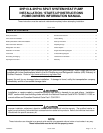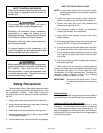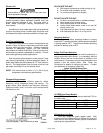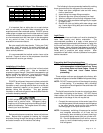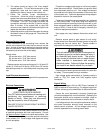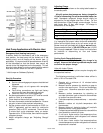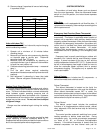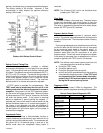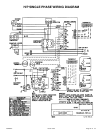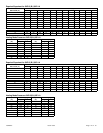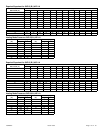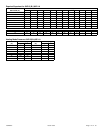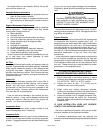
100402-07 Issue 0733 Page 5 of 18
2. The valves should be kept in the "front seated"
(closed) position. This will allow evacuation of the
refrigeration lines and the indoor coil, without
disturbing the factory charge in the outdoor unit.
3. Follow the vacuum pump manufacturer's
instructions. Allow the pump to operate until the
system has been evacuated down to 300 microns.
Allow the pump to continue running for an additional
15 minutes. Turn OFF the pump and leave the
connections secured to the two (2) service valves.
After 5 minutes, if the system fails to hold 500
microns or less, check all connections for tight fit and
repeat the evacuation procedure.
4. Isolate the vacuum pump from the system by closing
the shutoff valves on the gauge-set. Disconnect the
vacuum pump.
Opening Service Valves
After evacuation of the connecting lines, remove the
service valve cap and fully insert the hex wrench into the
stem. A back-up wrench is required on the valve body to
open the valve stem. Back-out counterclockwise until the
valve stem just touches the coined edge.
Wrench sizes:
3/8 service valve: 3/16" Hex wrench
3/4 service valve: 5/16" Hex wrench
7/8 service valve: 5/16" Hex wrench
Replace service valve cap and torque to 8-11 ft-lb on 3/8"
valves; 12-15 ft-lb on 3/4" valves; 15-20 ft-lb on 7/8" valves.
Use backup wrench on valve body when torqueing valve
cap.
Install Electrical Accessories
Refer to the instructions packaged with the accessories.
Electrical Connections
Be sure to check all local codes to determine that the unit
is installed accordance with local requirements. Consult
the National Electric Code
for wire size requirements. Use
60
/ C wire or higher. Always provide ground connections
to the outdoor unit. Power supply must agree with rating
on unit nameplate.
Provide line voltage power supply to unit from a properly
sized disconnect switch. Route power and ground wires
from disconnect switch to unit. Line voltage connections
are made at the line side of the contactor in the control box
of the outdoor unit. Follow the appropriate wiring diagram
attached to inside of the access panel.
Proper circuit protection recommendations are indicated
on Unit Rating Plate. Time delay fuses are required to
prevent blowing due to starting current (the current in rush
when equipment starts is referred to as the Locked Rotor
Amps or (LRA). A fuse of this kind properly sized will give
maximum equipment protection.
Use copper wire only between disconnect switch and
unit.
Remove access panel to gain access to unit wiring.
Extend wires from disconnect through power wiring hole
provided and into unit control box. Flexible conduit is
required for the swing out control box feature.
Connect ground wire to ground connection in control box
for safety. Connect power wiring to contactor.
High voltage power connections to 3-phase models is
made to "Pig Tail" leads with field supplied splice
connectors.
Control Wiring
The control voltage is 24 Vac. NEC Class I insulated 18
AWG is required for control wiring. For lengths longer than
150 feet, contact your local distributor for technical service.
Ensure the room thermostat is properly installed per
instructions shipped with room thermostat. Generally the
thermostat should not be exposed to sunlight, drafts or
vibration and should not be mounted on exterior walls.
Low voltage control wire connections should be made to
the screw connection terminal board mounted on the
defrost control as shown. All low voltage control wiring
must be separated from incoming power leads.
....
ELECTRICAL SHOCK HAZARD!
Turn OFF electric power before connecting unit,
performing any maintenance or removing
panels or doors. More than one disconnect
may be required to turn off all power.
FAILURE TO DO SO COULD RESULT IN BODILY
INJURY OR DEATH.
The unit cabinet must have an uninterrupted or
unbroken ground to minimize personal injury if
an electrical fault should occur. The ground
may consist of electrical wire or metal conduit
when installed in accordance with existing
electrical codes. Failure to follow this warning
can result in an electric shock, fire, or death.



